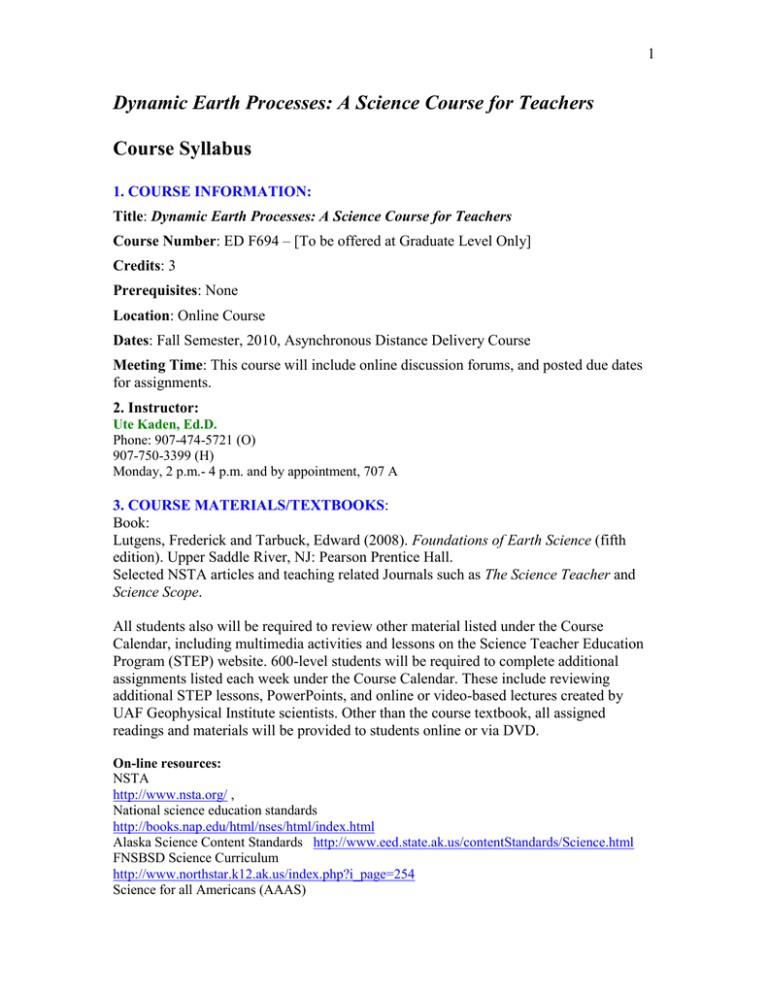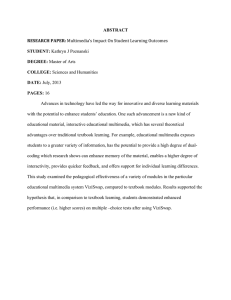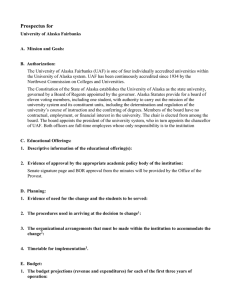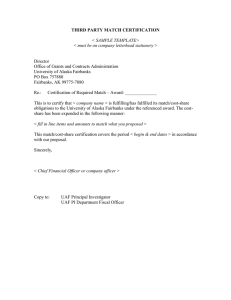
1
Dynamic Earth Processes: A Science Course for Teachers
Course Syllabus
1. COURSE INFORMATION:
Title: Dynamic Earth Processes: A Science Course for Teachers
Course Number: ED F694 – [To be offered at Graduate Level Only]
Credits: 3
Prerequisites: None
Location: Online Course
Dates: Fall Semester, 2010, Asynchronous Distance Delivery Course
Meeting Time: This course will include online discussion forums, and posted due dates
for assignments.
2. Instructor:
Ute Kaden, Ed.D.
Phone: 907-474-5721 (O)
907-750-3399 (H)
Monday, 2 p.m.- 4 p.m. and by appointment, 707 A
3. COURSE MATERIALS/TEXTBOOKS:
Book:
Lutgens, Frederick and Tarbuck, Edward (2008). Foundations of Earth Science (fifth
edition). Upper Saddle River, NJ: Pearson Prentice Hall.
Selected NSTA articles and teaching related Journals such as The Science Teacher and
Science Scope.
All students also will be required to review other material listed under the Course
Calendar, including multimedia activities and lessons on the Science Teacher Education
Program (STEP) website. 600-level students will be required to complete additional
assignments listed each week under the Course Calendar. These include reviewing
additional STEP lessons, PowerPoints, and online or video-based lectures created by
UAF Geophysical Institute scientists. Other than the course textbook, all assigned
readings and materials will be provided to students online or via DVD.
On-line resources:
NSTA
http://www.nsta.org/ ,
National science education standards
http://books.nap.edu/html/nses/html/index.html
Alaska Science Content Standards http://www.eed.state.ak.us/contentStandards/Science.html
FNSBSD Science Curriculum
http://www.northstar.k12.ak.us/index.php?i_page=254
Science for all Americans (AAAS)
2
http://www.project2061.org/tools/sfaaol/sfaatoc.htm
4. COURSE DESCRIPTION:
This 3 credit online course ED 694 for educators addressed Earth science content
standards and science teaching methodology. The content areas are based on National
Science Teacher Association (NSTA) standards and include the rock cycle, land features
and landforms, plate tectonics, volcanoes, earthquakes, tsunamis, the water cycle and
energy transfer in Earth’s atmosphere.
5. COURSE GOALS AND STUDENT LEARNING OUTCOMES:
- Increase knowledge/understanding of Earth’s dynamic processes using cutting
edge Alaska-based research.
- Introduction to best practice skills for science teaching.
- Introduce science process skills
- Use an Integrated approach to present dynamic Earth sciences
- Integrate current technology into curriculum using web resources (i.e. UAF
Geophysical Institute and Science Teacher Education Program Institute)
- Establish an online learning community teacher network.
- Provide teachers content with content knowledge and skills to increase student
achievement.
6. STUDENT LEARNING OUTCOMES:
- Understand the content of the 9 topics in Dynamic Earth processes through
successfully completing threaded discussions, quizzes, and final exam.
- Will gain knowledge to navigate current Alaska technology to include all web
resources including the Geophysical Institute STEP website through successfully
accessing all resources currently available.
- Utilize science process skills addressing NSES, Alaska Science Standards, Grade
Level Expectations
- Weekly interaction using web-based threaded discussion within a learning
community teacher network.
- Create a project demonstrating knowledge of how to apply learning of Earth
science processes to classroom instruction.
-
-
Have the knowledge and skills to meet the National Science Teachers Association
Standards for Teacher Preparation and become a 21st century
educator,http://www.nsta.org/pdfs/NSTAstandards2003.pdf,
Design research based, inquiry and technology-rich curriculum & assessment to engage
students in science, and to increase and measure student achievement,
3
-
Create a safe classroom environment for successful learning for all students (ELL, special
education, literacy).
7. INSTRUCTIONAL METHODS:
Blackboard: Course content can be accessed through blackboard http://classes.uaf.edu/
This course will include weekly assignments, periodic quizzes, a mid-term project, and a
final examination. An overview of these instructional methods is outlined below.
Weekly assignments for 400/600 level students:
Each week online course participants are required to:
Read affiliated chapters from the course textbook
Perform a related Multimedia Review of interactive visuals
Participate in online discussion forums learning communities)
Take an online quiz the reflects content learning
Use cyber -based laboratory activities
Students will be able to express what they learned as a result of weekly assignments
through weekly quizzes and online discussion forums (learning communities). These two
venues will offer multiple choice questions, interruptive/ comprehensive/ application
questions, short answer, and extended answers
Weekly assignments for 600 level students:
600 level students also will review additional visuals, and then prepare a classroom
lesson and a PowerPoint that illustrates their understanding of the additional
information learned. Both the classroom lesson and the PowerPoint created by 600-level
students will be posted to the course website. During online forums, 600-level students
will share their lessons and PowerPoint presentations and reflect on how the course
information they reviewed applies to classroom instruction. All 600 level participants
must submit the first presentation for posting before Week 8. Their second presentation
must be submitted for posting before Week 13.
Keystone requirement 600 level: Action research paper/scholarly paper on current issues
in science education in their community or in rural areas of Alaska.
Midterm Projects: Course participants will identify an existing curriculum and show how
10 or more Earth or Physical science lessons from the Science Teacher Education
Program (STEP) website and Lesson Databank can be used to augment the curriculum.
STEP lessons are based on Alaska Science Standards and Grade Level Expectations, and
have been written by teachers from around Alaska using the Alaska Science Consortium
Learning Cycle Model. Midterm projects will be posted on the course website. All course
participants are expected to participate in online discussion forums in which they engage
in peer review.
4
Using a STEP lesson model template provided, 600 level participants also will be
required to write at least one new classroom lesson based on the scientific information
learned in the course.
Final Comprehensive Exam: The final exam will be composed of a sampling of questions
from course weekly online quizzes.
8. COURSE CALENDAR
Each week all students will be responsible for reading the following text, reviewing the
following interactive visuals, and taking the online quiz. Additional assignments for
students taking the course at the 600 level are noted.
Week 1: Discovery
Text: Read:
The section “Brief Contents” at the front of the Foundations of Earth Science
Course Textbook
The “GEODe: Earth Science” description of the contents of the DVD stapled
inside the Course Textbook.
The online Syllabus
Multimedia Review:
Put the “GEODe: Earth Science” DVD from inside the Course Textbook into your
computer. Briefly navigate through the DVD and report any technical problems to
the course instructor.
Explore the Science Teacher Education Program (STEP) Website
(http://www.stepalaska.org)
Week 1 Discovery Hunt (prepared by the course instructor) provides a guided hunt for
other course assets, including: 1) online discussion forum, 2) folders containing each
weeks multimedia assets, 3) Location of Weekly Quizzes, 4) Locations for posting
Week 2: What is Earth Science?
Text: Read the “Introduction” for Course Textbook
Multimedia Review:
1) In the Course Multimedia Folder, review the following assets from Climate
Change in the Arctic: An Interactive Multimedia Learning System (copyright 2009,
Geophysical Institute, University of Alaska Fairbanks):
Explore the spheres
Ice Cores
Sediment Cores
Tree Rings
5
Animal Bones
2) In the Course Multimedia Folder, review the following assets (from Ola Ka Honua:
Volcanoes Alive, copyright 2007, Geophysical Institute, University of Alaska
Fairbanks)
Earth’s Layers
STEP Lesson Review
Go to the STEP website (http://www.stepalaska.org). Click the “Curricula” tab. Click
on the “Earth Systems” heading. Review the lessons under “Earth’s Layers.”
Additional assignment for 600-level students
Review the Lecture “How to Conduct an Experiment,” by Scientist Eric Stevens
Week 2 Quiz
Week 3 and Week 4: Minerals and the Rock Cycle
Text: In the Course Textbook, read:
Chapter 1 “Minerals: Building Blocks of Rocks,”
Chapter 2: “Rocks: Materials of the Solid Earth”
Multimedia Review:
On the “GEODe: Earth Science” DVD (included as part of the Course Textbook), review
all of (Unit 1) Earth’s Materials, including all sections of the following subheads:
A) Minerals (Sections 1-5)
B) Rock Cycle
C) Igneous Rocks (Sections 1-4)
D) Sedimentary Rocks (Sections 1-3)
E) Metamorphic Rocks (Sections 1-5)
STEP Lesson Review
Go to the STEP website (http://www.stepalaska.org). Click the “Curricula” tab. Click
on the “Earth Systems” heading. Review the lessons under “Rocks and Minerals.”
Additional assignment for 600-level students
Go to the STEP website (http://www.stepalaska.org). Click the “Curricula” tab. Click
on the “Earth Systems” heading. Review the lessons under lessons in the categories
under the subheading, “Surface Processes.”
Week 3 Quiz
Week 5 and 6: Land Features/Landforms
6
Text: Course Textbook:
Chapter 3: “Landscapes Fashioned by Water” and
Chapter 4: “Glacial and Arid Landscapes”
Multimedia Review:
1) On the “GEODe: Earth Science” DVD (included as part of the Course Textbook),
review all of (Unit 2) Sculpting Earth’s Surface, including,
A) Hydrologic Cycle
B) Running Water (Sections 1-2)
C) Groundwater (Sections 1-3)
D) Glaciers (Sections 1-3)
E) Deserts (Sections 1-3)
2) In the Course Multimedia Folder, review the following assets (from Climate
Change in the Arctic: An Interactive Multimedia Learning System, copyright 2009,
Geophysical Institute, University of Alaska Fairbanks):
Shaping Earth’s Surface
STEP Lesson Review
Go to the STEP website (http://www.stepalaska.org). Click the “Curricula” tab. Click
on the “Earth Systems” heading. Review the lessons under “Geologic Features.”
Additional assignment for 600-level students
Review the PowerPoint presentation “Remote sensing for studying earth surface and
changes”
Week 5-6 Quiz
Week 7: Plate Tectonics
Text: In the Course Textbook, read Chapter 5: “Plate Tectonics: A Scientific Theory
Unfolds”
Multimedia Review:
1) In the Course Multimedia Folder, review the following assets (from Ola Ka
Honua: Volcanoes Alive, copyright 2007, Geophysical Institute, University of
Alaska Fairbanks)
Wegener’s Theory
Pangaea Puzzle
Moving Crust
Sliding Plates
Plate Tectonics
Divergent Boundaries
Convergent Boundaries
Transform Boundaries
7
Earth’s Plates Puzzle
2) On the “GEODe: Earth Science” DVD (included as part of the Course
Textbook), review one segment of (Unit 3) Forces Within
Part B: Plate Tectonics (Sections 1-3)
STEP Lesson Review
Go to the STEP website (http://www.stepalaska.org). Click the “Curricula” tab. Click
on the “Earth Systems” heading. Review the lessons under “Plate Tectonics.”
Additional assignment for 600-level students
Review the Lecture “Plate Tectonics and Tsunami Origin,” by Scientist Cindi Preller
Week 7 Quiz
Week 8: Earthquakes
Text: In the Course Textbook, read Chapter 6: “Restless Earth: Earthquakes, Geologic
Structures, and Mountain Building”
Multimedia Review:
1) On the “GEODe: Earth Science” DVD (included as part of the Course
Textbook), review one segment of (Unit 3) Forces Within
Part A: Earthquakes (Sections 1-5)
2) In the Course Multimedia Folder, review the following assets (from Ola Ka
Honua: Volcanoes Alive, copyright 2007, Geophysical Institute, University of
Alaska Fairbanks)
Recording Earthquakes
Don’t forget the Match Seismogram Game!
3) In the Course Multimedia Folder, review the following assets (from the Alaska
Tsunami Education Program, copyright 2009, Geophysical Institute, University of
Alaska Fairbanks)
Earthquake Time Machine
STEP Lesson Review
Go to the STEP website (http://www.stepalaska.org). Click the “Curricula” tab. Click
on the “Earth Systems” heading. Review the lessons under “Earthquakes.”
Additional assignment for 600-level students
Review the Lecture “Earthquakes in Alaska,” by Scientist Jamie Roush
Week 8 Quiz
8
Week 9: Volcanoes
Text: Course Textbook: Chapter 7: “Fires Within: Igneous Activity”
Multimedia Review:
1) On the “GEODe: Earth Science” DVD (included as part of the Course
Textbook), review one segment of (Unit 3) Forces Within
Part C: Igneous Activity (Sections 1-5)
2) In the Course Multimedia Folder, review the following assets (from Ola Ka
Honua: Volcanoes Alive, copyright 2007, Geophysical Institute, University of
Alaska Fairbanks)
Composite Volcano
Shield Volcano
Lava Flows
Tephra
Gas
Magma
Shield and Composite Hazards
STEP Lesson Review
Go to the STEP website (http://www.stepalaska.org). Click the “Curricula” tab. Click
on the “Earth Systems” heading. Review the lessons under “Volcanoes.”
Additional assignment for 600-level students
Review the Lecture “Volcanoes,” by Scientist Guy Tytgat
Week 9 Quiz
Week 10: Midterm Exam and Projects
Course participants will identify a curricula used in their school. For their Midterm
assignment, they will show how 10 or more Earth or Physical science lessons from the
STEP website can be used to augment their school curricula. STEP lessons are based on
Alaska Science Standards and Grade Level Expectations, and have been written by
teachers from around Alaska using the Alaska Science Consortium Learning Cycle
Model. Midterm projects will be posted on the course website. All course participants are
expected to participate in online discussion forums in which they engage in peer review.
All students will be expected to discuss which STEP lessons they chose to teach to their
classrooms & why.
Using a STEP lesson model template provided, 600 level participants also will be
required to write at least one new classroom lesson based on the scientific information
learned through the Additional Assignments they have been engaging in each week.
9
Week 11 and Week 12: Oceans and Tsunamis
Text: Course Textbook:
Chapter 9: “Oceans: The Last Frontier”
Chapter 10: “The Restless Ocean”
Multimedia Review:
1) On the “GEODe: Earth Science” DVD (included as part of the Course Textbook),
review (Unit 3) The Global Ocean
A) Floor of the Ocean (Sections 1-3)
B) Coastal Processes (Sections 1-3)
2) In the Course Multimedia Folder, review the following assets (from Climate
Change in the Arctic: An Interactive Multimedia Learning System, copyright
2009, Geophysical Institute, University of Alaska Fairbanks):
Great Ocean Conveyor Belt
3) In the Course Multimedia Folder, review the following assets (from the Alaska
Tsunami Education Program, copyright 2009, Geophysical Institute, University of
Alaska Fairbanks)
How a Tsunami Forms
Underwater Slide Generating a Tsunami Wave (Visualization by the Arctic
Region Supercomputing Center, and the Alaska Earthquake Information Center,
University of Alaska Fairbanks)
Generation of Tsunami by Subduction Zone Earthquake (Visualization by the
Arctic Region Supercomputing Center, University of Alaska Fairbanks)
Wave Interference
STEP Lesson Review
Go to the STEP website (http://www.stepalaska.org). Click the “Curricula” tab. Click
on the “Earth Systems” heading. Review the lessons under “Tsunami.”
Additional assignment for 600-level students
Review the Lecture “Tsunamis,” by Scientist Elena Suleimani
Week 11-12 Quiz
Week 13: The Atmosphere, Energy and Heat Transfer
Text: Course Textbook: Chapter 11: “Heating the Atmosphere
Multimedia Review:
1) On the “GEODe: Earth Science” DVD (included as part of the Course Textbook),
review one portion of (Unit 6) Earth’s Dynamic Atmosphere
A) Heating the Atmosphere (Sections 1-5)
10
2) In the Course Multimedia Folder, review the following assets (from Climate
Change in the Arctic: An Interactive Multimedia Learning System, copyright
2009, Geophysical Institute, University of Alaska Fairbanks):
Earth’s Weather
Climate vs Weather
Greenhouse Gases
Earth’s Atmosphere
Greenhouse Gas Analyzer
Enhanced Greenhouse Effect
How Carbon Dioxide is Released
1000 years of change
Cryosphere (and Albedo)
STEP Lesson Review
Go to the STEP website (http://www.stepalaska.org). Click the “Curricula” tab. Click
on the “Climate Systems” heading. Review the lessons under “Climate Change.”
Additional assignment for 600-level students
Go to the STEP website (http://www.stepalaska.org). Click the “Curricula” tab. Click
on the “Climate Systems” heading. Review the lessons under “Carbon Cycle.”
Week 13 Quiz
600-level student PowerPoint presentation on knowledge gained through additional
assignments must be posted to the course website by the end of Week 13.
Week 14: The Water Cycle, Clouds and Precipitation
Text: Course Textbook: Chapter 12 “Moisture, Clouds, and Precipitation
Multimedia Review:
1) On the “GEODe: Earth Science” DVD (included as part of the Course Textbook),
review one portion of (Unit 6) Earth’s Dynamic Atmosphere
B) Moisture and Cloud Formation (Sections 1-4)
2) In the Course Multimedia Folder, review the following assets (from Climate Change
in the Arctic: An Interactive Multimedia Learning System, copyright 2009,
Geophysical Institute, University of Alaska Fairbanks):
Earth’s Water
Hydrologic Cycle
Changing Phases
Water’s Energy
11
Moving Molecules
Clouds
Clouds Game
Cloud Formation
STEP Lesson Review
Go to the STEP website (http://www.stepalaska.org). Click the “Curricula” tab. Click
on the “Climate Systems” heading. Review the lessons under “Water Cycle.”
Additional assignment for 600-level students
Go to the STEP website (http://www.stepalaska.org). Click the “Curricula” tab. Click
on the “Climate Systems” heading. Review the lessons under “Weather Basics.”
Week 14 Quiz
Week 15: Final Exam
The final exam will be composed of a sampling of questions from course weekly online
quizzes.
9. COURSE POLICIES
This is an online, asynchronous course. For this reason, the timely taking of weekly
quizzes and individual student contributions to weekly online discussion forums is
essential. On Monday of each week, the instructor will post questions related to course
weekly assignments in an online discussion forum. Students are expected to respond to
the instructor’s question and those posted by others in the class by 5 pm Friday. Make up
assignments will be arranged as necessary. Participation in online discussion and timely
completion of weekly assignments is required.
12
Students’ Academic Responsibilities
Students are expected to be diligent in their studies and attend class regularly and on
time. Students are responsible for all class work and assignments.
Academic Integrity
High ethical standards are essential for maintaining credibility. Every course at UAF
seeks to maintain these standards, starting with an emphasis on producing original and
factual work. Students who engage in scholastic dishonesty are subject to disciplinary
penalties, including the possibility of failure in the course and expulsion from the
University. Scholastic dishonesty includes but is not limited to cheating, plagiarism,
collusion, and submission for credit of any work or materials that are attributable in
whole or in part to another person, taking an examination for another person, any act
designed to give unfair advantage to a student, or the attempt to commit such acts. Since
scholastic dishonesty harms the individual, all students and the integrity of the
University, policies on scholastic dishonesty will be strictly enforced. (Board of Regents
Rules and Regulations)
All scholastic dishonesty incidents will be reported to the Dean of Students. Do not allow your
peers to pressure you to cheat. Your grade, academic standing and personal reputation are at
stake.
10. EVALUATION:
Grades will be based on the following:
1. Participation in Online Learning Community: 25%
2. Successful completion of weekly quizzes: 25%
3. Midterm Projects: 25%
4. Final Exam: 20%
A grade of A will be given for an overall score of 90% or better. A grade of B will be
given for 80-89%, C for 70-79%, D for 60-69% and F for <60%.
Title
Learning
Community
Description
Threaded
discussion and
reflections
Components
Quantitative
Number
Percentage of
Grade
Comments
10
400-level students must post
a minimum of one entry each
week.
600-level students must post
a minimum of two entries per
week.
13
Online Quiz
Each week of
instruction
Content
Quality
15
Ideal
Components
25
Project
Described under Week 10 on
the Course Syllabus (under
Calendar)
25
Exam
Final
25
For both 400- and 600-level
students, the content of the
discussion threads must
reflect weekly assignments
Weekly Quizzes reflect
science content. 600-level
students will have questions
on their additional
assignments.
400-level students and 600level students will need to
complete a syllabus that
includes STEP lessons.
600-level students must also
write a lesson based on the
STEP model.
Questions will be pulled
from weekly quizzes for both
400- and 600-level students.
11. SUPPORT SERVICES
UAF hosts e-learning class management software that supports online courses offered
for credit. Because UAF uses Blackboard (v. 8), this software will host the proposed
course in a central location. It also will offer secure access for all Development Team
members and enrolled teachers, and provide free management, automatic tracking,
assessment tools, and support services as needed.
12. DISABILITIES SERVICES
The Office of Disability Services implements the Americans with Disabilities Act
(ADA), and ensures that UAF students have equal access to the campus and course
materials. We will work with the Office of Disability Services (203 WHIT, 474-7043) to
provide reasonable accommodations to students with disabilities.



